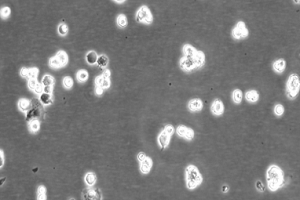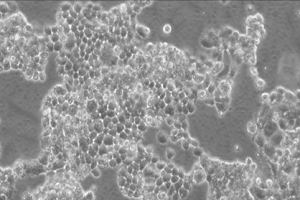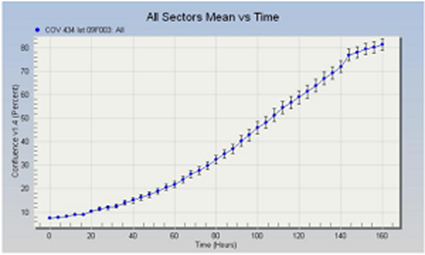Cell line profile COV434
(ECACC catalogue no. 07071909)
Cell line history
The immortalised granulosa cell line COV434 was isolated from a primary granulosa cell tumour of a 27 year old female suffering from a metastatic granulosa cell carcinoma. It is considered to be the first, and still one of the very few existing cell lines to display several properties considered essential for normal human granulosa cell function. It is now widely used in the investigation of human granulosa cells, most specifically in juvenile and adult ovarian cancer research.


COV434 cells 24 hours after seeding COV434 cells after four days in culture
Key characteristics
The COV434 cell line retains many characteristics and properties owned by natural granulosa cells, such as diploidy, growth in small follicle-like aggregates and formation of intercellular gap junctions when co-cultured with native cumulus cells. An increase in 17-oestradiol secretion and elevated proliferation in response to FSH stimulation can be observed with this cell line, which confirms the presence of intact FSH receptors, a feature highly specific to human granulosa cells. Other biological characteristics include the absence of the LH receptor, no luteinisation capability, and the presence of specific molecular markers of apoptosis enabling the induction of follicular atresia.
Applications
This cell line is a precious tool for in vitro studies of ovarian function because of the restricted availability and very short life span of primary granulosa cells. It also has the advantage to exhibit physiological responses similar to primary cells. Although they originate from a metastatic tumour, the cells still possess certain morphological and physiological characteristics of normal granulosa cells, which make them a good cell model for both normal and pathological conditions. It has been used in various studies trying to uncover the molecular pathways that govern granulosa cells tumour growth, in cytotoxicity assays using chemotherapy drugs and in finding targets for new drug therapies.
Culture tips
Cells grow in DMEM + 2mM Glutamine + 10% FBS and are normally seeded at a density of 2x104 cells/cm2. Dilution should not exceed 1:5, as they are growing slowly, taking at least one week to reach maximum density at minimum dilution. As the COV434 cell line grows in clusters, it will never fully cover the culture surface and only reach about 80% confluence.
Growth profile

|
Related cell lines |
ECACC catalogue number |
Description |
|---|---|---|
|
COV318 |
Human ovarian epithelial-serous carcinoma, peritoneal ascites |
|
|
COV362 |
Human ovarian epithelial-endometroid carcinoma |
|
|
COV362.4 |
Human ovarian epithelial-endometroid carcinoma, pleural effusion |
|
|
COV413A |
Human ovarian epithelial-serous carcinoma, sigmoid |
|
|
COV413B |
Human ovarian epithelial-serous carcinoma, bladder dome |
|
|
COV434 |
Human ovarian granulosa tumour |
|
|
COV504 |
Human ovarian epithelial-serous carcinoma, pleural effusion |
|
|
COV644 |
Human ovarian epithelial-mucinous carcinoma, primary tumour |
Key references
Van den Berg-Bakker CA, Hagemeijer A, Franken-Postma EM, Smit VT, Kuppen PJ, van Ravenswaay Claasen HH, Cornelisse CJ, Schrier PI 1993 Establishment and characterization of 7 ovarian carcinoma cell lines and one granulosa tumor cell line: growth features and cytogenetics. Int J Cancer. 53(4):613-20.
Zhang H, Vollmer M, De Geyter M, Litzistorf Y, Ladewig A, Dürrenberger M, Guggenheim R, Miny P, Holzgreve W, De Geyter C. 2000 Characterization of an immortalized human granulosa cell line (COV434). Mol Hum Reprod. 2000 6(2):146-53.
Cortes-Wanstreet MM, Giedzinski E, Limoli CL, Luderer U 2009 Overexpression of glutamate–cysteine ligase protects human COV434 granulosa tumour cells against oxidative and -radiation-induced cell death. Mutagenesis. 24 (3):211-24.
Fransolet M, Henry L, Labied S, Noël A, Nisolle M, Munaut C 2015 In vitro evaluation of the anti-apoptotic drug Z-VAD-FMK on human ovarian granulosa cell lines for further use in ovarian tissue transplantation. J Assist Reprod Genet. 32(10) 1551-59.
Bildik G, Akin N, Senbabaoglu F1, Sahin GN, Karahuseyinoglu S, Ince U, Taskiran C, Selek U, Yakin K, Guzel Y, Ayhan C, Alper E, Cetiner M, Balaban B, Mandel NM, Esen T, Iwase A, Urman B, Oktem O 2015 GnRH agonist leuprolide acetate does not confer any protection against ovarian damage induced by chemotherapy and radiation in vitro. Hum Reprod. 30(12):2912-25
Lunger F, Vehmas AP, Fürnrohr BG, Sopper S, Wildt L, Seeber B 2016 Opiate receptor blockade on human granulosa cells inhibits VEGF release. Reprod Biomed. Online 32(3):316-22.
